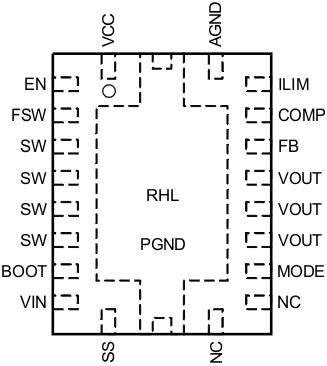SLVSE52A September 2018 – November 2018 TPS61088-Q1
PRODUCTION DATA.
- 1 Features
- 2 Applications
- 3 Description
- 4 Revision History
- 5 Description (continued)
- 6 Pin Configuration and Functions
- 7 Specifications
- 8 Detailed Description
- 9 Application and Implementation
- 10Power Supply Recommendations
- 11Layout
- 12Device and Documentation Support
- 13Mechanical, Packaging, and Orderable Information
Package Options
Mechanical Data (Package|Pins)
- RHL|20
Thermal pad, mechanical data (Package|Pins)
- RHL|20
Orderable Information
6 Pin Configuration and Functions
RHL Package
20 Pin VQFN With Thermal Pad
Top View

Pin Functions
| PIN | I/O | DESCRIPTION | |
|---|---|---|---|
| NAME | NUMBER | ||
| VCC | 1 | O | Output of the internal regulator. A ceramic capacitor of more than 1 µF is required between this pin and ground. |
| EN | 2 | I | Enable logic input. Logic high level enables the device. Logic low level disables the device and turns it into shutdown mode. |
| FSW | 3 | I | The switching frequency is programmed by a resister between this pin and the SW pin. |
| SW | 4, 5, 6, 7 | I | The switching node pin of the converter. It is connected to the drain of the internal low-side power MOSFET and the source of the internal high-side power MOSFET. |
| BOOT | 8 | O | Power supply for high-side MOSFET gate driver. A ceramic capacitor of 0.1 µF must be connected between this pin and the SW pin |
| VIN | 9 | I | IC power supply input |
| SS | 10 | O | Soft-start programming pin. An external capacitor sets the ramp rate of the internal error amplifier's reference voltage during soft-start |
| NC | 11, 12 | — | No connection inside the device. Connect these two pins to ground plane on the PCB for good thermal dissipation |
| MODE | 13 | I | Operation mode selection pin for the device in light load condition. When this pin is connected to ground, the device works in PWM mode. When this pin is left floating, the device works in PFM mode. |
| VOUT | 14, 15, 16 | O | Boost converter output |
| FB | 17 | I | Voltage feedback. Connect to the center tape of a resistor divider to program the output voltage. |
| COMP | 18 | O | Output of the internal error amplifier, the loop compensation network should be connected between this pin and the AGND pin. |
| ILIM | 19 | O | Adjustable switch peak current limit. An external resister should be connected between this pin and the AGND pin. |
| AGND | 20 | — | Signal ground of the IC |
| PGND | 21 | — | Power ground of the IC. It is connected to the source of the low-side MOSFET. |